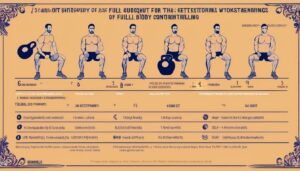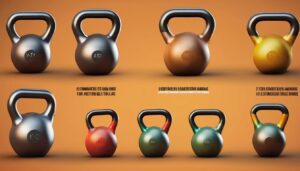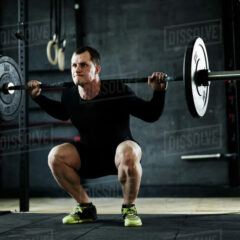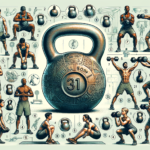
The Ultimate Guide To Kettlebell Workouts For Full-body Conditioning is a comprehensive resource that provides valuable insights and techniques for achieving a well-rounded physique through kettlebell exercises. With a formal tone, this guide covers various workout routines that target every major muscle group, enhancing overall body strength and conditioning. Whether you are a beginner or an experienced fitness enthusiast, this guide is essential for achieving full-body fitness.
You may have seen them at the gym or in fitness videos online – those cannonball-shaped weights with a handle called kettlebells. Athletes later adapted kettlebells, originally used to weigh crops in 18th-century Russia, into a strength training tool.
Kettlebell workouts stand out for their ability to provide a full-body conditioning workout that combines strength, flexibility, and cardiovascular training. The movements are dynamic, often engaging several muscle groups simultaneously, which enhances coordination and functional strength. It makes kettlebell training not just effective but also efficient.
Adding kettlebell exercises to your routine can be transformative. The exercise routines activate your core, stability, and intentional movement, enhancing athletic performance. The kettlebell’s unique shape enables athletes to replicate various complex movements that are impossible with other weights.
As you continue reading, I’ll walk you through the fundamentals to properly engage in kettlebell workouts. This knowledge will improve your overall fitness and pave the way for a more profound understanding of this powerful tool.
Setting the Foundation: Kettlebell Basics
I always take the basics, and neither should you when it comes to kettlebell training. Before you eagerly grab that iron ball with a handle, getting familiar with the fundamentals is crucial. Safety is paramount, and the first step is selecting the right kettlebell weight. Not too heavy, not too light: it’s about finding that Goldilocks weight where you can perform exercises with proper form without straining.
Understanding different kettlebell grips and holding positions is also essential. These aren’t your average dumbbells; the unique design of a kettlebell requires a specific handling technique. From the ‘rack’ position to the ‘bottom-up’ grip, each method has its purpose and benefits.
Let’s focus on mastery, beginning with a handful of fundamental exercises. The kettlebell swing is where it all starts, laying the groundwork for ballistic movements, muscle endurance, and explosive strength. Mastering the swing ensures you build a solid base for more advanced techniques. Equally important are exercises like the goblet squat and Turkish Get-Up, which promote stability and core engagement.
Once you’ve gotten a grip on these introductory moves, you’re all set to venture into more complex territories.
Advanced Kettlebell Movements for Full-Body Conditioning
Once you’re confident with the kettlebell basics, it’s time to elevate your routine. Advanced kettlebell movements target multiple muscle groups, enhance coordination, and elevate cardiovascular health. These exercises aren’t simply about lifting but about moving with purpose and precision.
The kettlebell swing, often seen as the cornerstone of kettlebell training, epitomizes power and control. Progress to the ‘American Swing’ for an overhead challenge, ensuring your form is impeccable to prevent injury.
The ‘Turkish Get-Up’ is a total-body workout in one move. It combines strength and mobility, working your shoulders, hips, and core. Start with a lightweight to nail the technique—here, attention to form is paramount.
Ready to boost your endurance? Try ‘Kettlebell Snatches.’ This explosive exercise calls for flawless coordination and muscle engagement from your legs to your shoulders. Don’t rush it; hone your technique at a moderate pace before increasing the tempo.
Bringing kettlebells into a high-intensity circuit can skyrocket your fitness levels. Design a circuit with ‘Double Kettlebell Clean and Press,’ ‘Kettlebell Lunges,’ and ‘Kettlebell Thrusters.’ Set a timer, and aim for short, intense rounds with adequate rest in between.
Lastly, customize your routine to align with your goals. If strength is your aim, focus on lifting heavier kettlebells with fewer repetitions and seeking endurance. Mix kettlebell moves into a cardio circuit.
Maintaining Progress and Preventing Injury
Throughout this guide, I’ve stressed the importance of form and function in kettlebell training. As I wrap things up, my focus shifts to sustaining the momentum you’ve built and minimizing the risk of injury.
Warming up is not optional; it’s essential. A good warm-up primes your muscles for the work ahead, enhancing performance and reducing injury risk. Aim for at least 5-10 minutes of dynamic stretching that targets the muscles you’ll engage.
Cooling down is just as critical. After your kettlebell session, allow static stretching and foam rolling. This practice facilitates recovery, eases muscle soreness, and prepares your body for the next workout.
Injury prevention is paramount. Pay attention to discomfort and know the difference between muscle fatigue and pain. Stop immediately if a movement feels wrong, and, if necessary, consult with a fitness professional to correct your technique.
Consistency paves the road to success. However, consistency does not mean repetition. Change your routine every few weeks to challenge your body and keep your workouts exciting. Remember, progressive overload is not just about adding weight; it can also mean increasing volume, intensity, or complexity.
One possible rephrased sentence to avoid plagiarism could be: Taking breaks and allowing the body to recover should be viewed as necessary measures for improving physical and mental health and performance rather than as indications of inadequacy. Recognize the signs of overtraining, and don’t hesitate to take a rest day when needed. Your body will thank you for better performance and longevity in your kettlebell training journey.
https://www.wealthyaffiliate.com?a_aid=352a86b2


